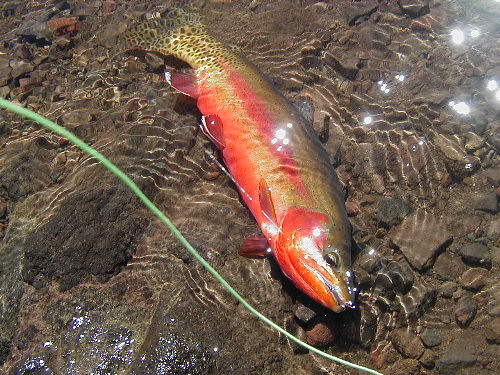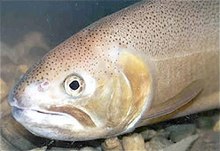This week, for reasons of force majeure, and I do not 'technically possible to compile a complete post.
Luckily the life of a blogger (like the real one) is not 'made only after and committed seriousness'. Today
then sit back in his chair and relax, go for a succession of species of trout phenotypically significant. With a few notes in the margin.
golden trout (© Gino-Flick)
Golden trout Oncorhynchus
(mykiss) aguabonita
E 'the fish of the State of California and e 'as originating in the Golden Trout Creek (fancy eh?). It was formerly considered a separate species threatened by introductions of brown trout and rainbow trade (which are derived from steeelhead). Lately seems to have fallen to the rank of sub-species of steelhead, which la nuova denominazione.
In questo caso e' forse sbagliato parlare di sub-specie o di specie ma si puo' parlare forse di semispecie: non c'e' molto accordo fra gli autori su quale sia la denominazione valida e se le specie siano effettivamente allopatriche e difficilmente ci sara' mai.
Inoltre attenzione alla confusione con la Golden Rainbow Trout che e' invece il prodotto di selezioni ed incroci tra trote iridee ed e' sostanzialmente una trota iridea albina (ma non necessariamente sterile) e di simile ha solo il nome.
In ogni modo una trota con una bellissima livrea ed una specie a rischio.
Trote dalla gola tagliata di Yellowstone (©FishEyeGuyPhotography)
Cutthroat trout Oncorhynchus clarkii
Until recently it was named Salmo clarkii and were attributed to about 16 subspecies, now wants the fashion Onchorynchus reclassified in the genus that includes all salmon and trout peaceful. The number of subspecies seems to have fallen to 11.
are spread throughout the chain of the Rocky Mountains and a few people and 'also anadromous, dating from the Pacific. In reality, 'it seems that many of the subspecies are virtually identical from a genetic perspective.
trout red line (Sportsman © Habitat)
Redband trout Oncorhynchus mykiss gairdneri
native of Colorado and Fraser rivers' (maybe) a subspecies of rainbow trout. What was once defined as trutta Salmo gairdneri . Presents us with 'a band of color more' alive and more black spots' and large white tips on fins. It grows and grows so quickly that almost all of the rainbow. At the time, and not 'in particular danger.
An Apache trout ( © U.S. Fish and Wildlife)
Apache trout Oncorhynchus
(gilae) apache
Described alternately as a subspecies or as a species in itself and 'a trout widespread in Arizona and is characterized by small spots spread throughout the body. Features are the spots around the eyes. The population of this trout and 'a critical state and in an effort to eliminate the main cause of degradation (the genetic hybridization) is completely sterilize streams compromise.
Gila trout (Wikimedia commons)
Gila trout Oncorhynchus
gilae gilae
It 's a very special trout adapted to live in the rivers of Arizona and New Mexico. Small in size, its livery and 'characterized by numerous small spots in the upper body. Together with the Apache trout, it shares some habitats, and 'a risk endemic to North America. Over the past 30 years have made considerable efforts to conserve the species (threatened by habitat modification and hybridization).
After this brief a question may arise spontaneously: why so much confusion in the classification of trout?
The trout in the broad sense (genera Salmo and Onchorynchus) are fish with a plastic 'very easily formed and the particular characteristics of each environment that colonize, this means that potentially every single river and lake would have its species or subspecies, not just at times we may find morpho even within the same system.
It 's so that they are currently defined American trout, a subspecies for each basin.
classification and should be considered that 'only a number of comfortable boxes that we build to put in the animals and do not necessarily reflect the phylogenetic analysis of living beings. Periodically, this classification will be 'called into question by some data and will propose new classifications are able to agree better with available data (at least according to the authors).
For now, instead of breaking my head on the classification of trout (which the other group are not even the most 'complicated), we just enjoy their beauty.
PS The nomenclature of the species listed in this article, and 'what is the most popular today, but many scientists, conservators and fishermen continue to use different definitions.
PS 2 The inspiration for this article and I 'came after reading the number 35 of Fisheries






0 comments:
Post a Comment